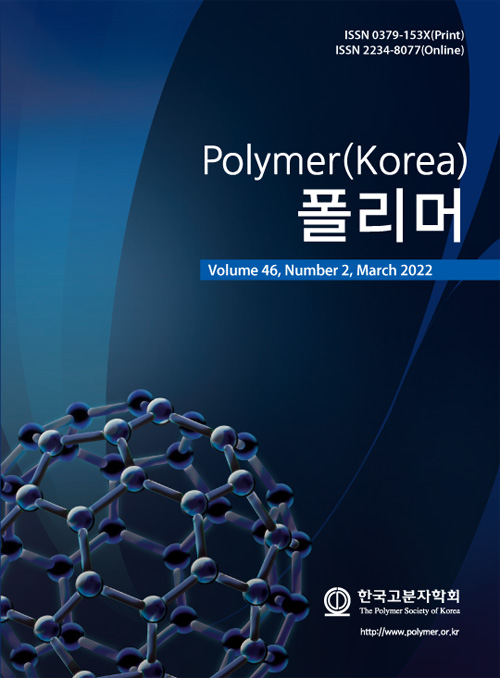- Fabrication of Bilayered Porous Membranes for Controlling Tissue Regeneration
*Department of Biomedical Engineering, Daegu Catholic University, Gyeongsan 38430, Korea
**School of Advanced Materials and Chemical Engineering, Daegu Catholic University, Gyeongsan 38430, Korea- 조직재생 속도 조절을 위한 이중층 구조 다공성 멤브레인 제조
*대구가톨릭대학교 의공학과, **대구가톨릭대학교 신소재화학공학부
Reproduction, stored in a retrieval system, or transmitted in any form of any part of this publication is permitted only by written permission from the Polymer Society of Korea.
The use of bilayered membranes has attracted great attention in guided bone regeneration applications because they closely simulate the major features of the natural extracellular matrix (ECM) of bone tissue. In this study, bilayered porous membranes were prepared by using freeze-drying and electrospinning for significantly improved prevention of soft tissue infiltration and regeneration of bone tissue through controlling the cell growth of soft and bone tissues. The resulting porous membranes exhibited three-dimensionally interconnected pore structures. The results of cytocompatibility tests assessed with soft and bone tissue cells revealed that collagen nanofiber layer promoted more rapid proliferation and differentiation of cells compared with GEAL51 membrane layer. These results suggest that bilayered porous membranes can stimulate cell growth to exhibit similar regeneration of soft and bone tissues.
이중층 구조를 가진 멤브레인은 자연 상태 골조직의 세포외기질(extracellular matrix, ECM)과 유사한 구조를 가지고 있기 때문에 골유도재생술에서 많은 관심을 받고 있다. 본 연구에서는 동결건조법과 전기방사법을 이용하여 연조직과 골조직의 재생 속도를 조절함에 의해서 연조직 차단 효과와 골조직 재생능을 극대화할 수 있는 이중층 구조를 가진 다공성 멤브레인을 제조하였다. 제조된 이중층 구조 다공성 멤브레인은 삼차원 네트워크 구조의 상호연결된 기공구조를 보였다. 다공성 멤브레인의 연조직 및 골조직 세포의 성장에 미치는 영향을 조사한 결과 콜라겐 나노섬유층이 GEAL51 멤브레인층보다 세포 성장 및 분화를 더욱 촉진시켰다. 또한 이중층 구조 다공성 멤브레인을 사용할 경우 연조직과 골조직의 재생 속도가 비슷하게 조절될 수 있는 가능성이 확인되었다.
Keywords: bilayer, porous membrane, tissue regeneration, freeze drying, electrospinning.
- Polymer(Korea) 폴리머
- Frequency : Bimonthly(odd)
ISSN 0379-153X(Print)
ISSN 2234-8077(Online)
Abbr. Polym. Korea - 2023 Impact Factor : 0.4
- Indexed in SCIE
 This Article
This Article
-
2022; 46(2): 208-215
Published online Mar 25, 2022
- 10.7317/pk.2022.46.2.208
- Received on Nov 9, 2021
- Revised on Dec 4, 2021
- Accepted on Dec 10, 2021
 Correspondence to
Correspondence to
- Young-Jin Kim
-
*Department of Biomedical Engineering, Daegu Catholic University, Gyeongsan 38430, Korea
**School of Advanced Materials and Chemical Engineering, Daegu Catholic University, Gyeongsan 38430, Korea - E-mail: yjkim@cu.ac.kr










 Copyright(c) The Polymer Society of Korea. All right reserved.
Copyright(c) The Polymer Society of Korea. All right reserved.